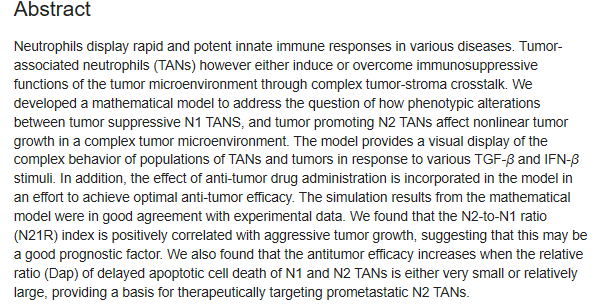논문
Role of tumor-associated neutrophils in regulation of tumor growth in lung cancer development: A mathematical model
- 저자Yangjin Kim(SeongWon Lee)
- 학술지PLoS One 14(1)
- 등재유형
- 게재일자(2019)

Adstract
Neutrophils display rapid and potent innate immune responses in various diseases. Tumor-associated noutrophils (TANs) however either induce or overcome immunosuppressive funcitions of the tumor microenvironment through complex tumor-strma crosstalk. We developed a mathematical model to address the question of how phenotypic alterations between tumor suppressive N1 TANS, and tumor promoting N2 TANs affect nonlinear tumor growth in a cmplex tumor microenvironment. The model provides a visual display of the compex behavior of populations of TANs and tumors in response to various TGF- and IFN- stimuli. in addition, the effect of anti-tumor efficacy. The simlation results from the mathematical model were in good agreement with experimental data. We found that the N3-toN1 ratio (N21R) index is positively correlated with aggressive tumor guowth, suggesting that this may be a good prognostic factor. We also found that the anititumor efficacy increases when the relative ratio (Dap) of delayed apeptotic cell death of N1 and N2 TANs is either very small or relatively large, providing a basis for therapeutically targeting prometastatic N2 TANs.

Adstract
Neutrophils display rapid and potent innate immune responses in various diseases. Tumor-associated noutrophils (TANs) however either induce or overcome immunosuppressive funcitions of the tumor microenvironment through complex tumor-strma crosstalk. We developed a mathematical model to address the question of how phenotypic alterations between tumor suppressive N1 TANS, and tumor promoting N2 TANs affect nonlinear tumor growth in a cmplex tumor microenvironment. The model provides a visual display of the compex behavior of populations of TANs and tumors in response to various TGF- and IFN- stimuli. in addition, the effect of anti-tumor efficacy. The simlation results from the mathematical model were in good agreement with experimental data. We found that the N3-toN1 ratio (N21R) index is positively correlated with aggressive tumor guowth, suggesting that this may be a good prognostic factor. We also found that the anititumor efficacy increases when the relative ratio (Dap) of delayed apeptotic cell death of N1 and N2 TANs is either very small or relatively large, providing a basis for therapeutically targeting prometastatic N2 TANs.














